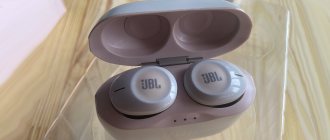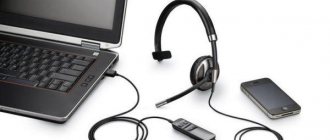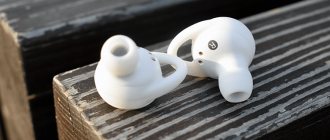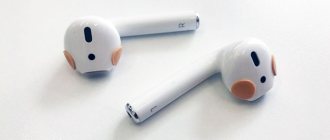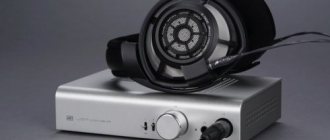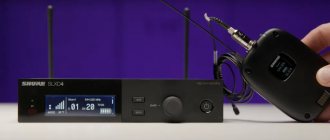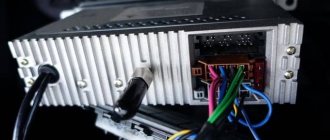A microphone is an indispensable device used for making calls and controlling voice commands when working with a computer or laptop. Manufacturers produce headsets with a built-in microphone - the most convenient option for use. But the device may fail. Before repairing, you need to find the reason why the built-in microphone on the headphones does not work.
Headphones with microphone
DIY headphone repair
Most often, small-sized models used in mobile communication devices fail. These are miniature capsules connected to a smartphone with a thin wire. The sound device includes the following elements:
- Sound emitters
- Volume control
- Connecting wires
- Plug
You can repair headphones for your phone at home. The most common defect is broken connecting wires. They are very thin and have poor insulation. In order to determine the break point, you need to connect the headphones to an audio device, turn on a piece of music and sequentially “wash” the entire connecting wire with your hands. At the break point, the sound will appear and disappear. Most often, a wire break occurs at the junction of the wire with structural elements. This is the wire entry into the plug body, the volume control input and output, the connection point to the left and right capsules, and the wire splitter into two channels. In addition to breaks at the connection points, the wire can be damaged by pets.
To repair headphones, it is not necessary to change the entire wire. It is necessary to localize the location of the contact failure, disassemble the specific unit and restore the integrity of the connection using soldering. How to fix headphones if the contact at the plug is broken.
The connector (plug) can be linear or “L”-shaped. In any case, it will not be possible to save the plastic cap, since it is not dismountable. It should be carefully cut with a sharp blade. Usually the contact failure is located at the plug itself. Before removing the wire, you need to remember the colors of the conductors soldered to the plug contacts. The wire is cut, the insulation is removed, and the individual conductors are stripped for soldering. The conductors in the veins are very thin and consist of a bundle of wires together with threads made of synthetic material. Each copper wire is varnished. It is difficult to remove the insulating coating with a sharp cutting tool without skill, so it is easier to burn the varnish in the flame of a lighter.
Then the cleaned ends of the wire need to be tinned. For this, rosin, an alcohol solution of rosin or a paste-like flux are used. Using a heated soldering iron, apply a small amount of solder to the flux-treated wire. Remnants of factory soldering are removed from the plug contacts. Before soldering, a small piece of heat-shrink tubing is placed on the wire. It will replace the cut plug housing. The prepared and tinned wires are soldered to the corresponding contacts of the connector. A heat-shrinkable tube is placed on the plug and heated with a household hairdryer or lighter. This way you can repair the headphones at home.
What to do if the headphones break at the sound capsule. To eliminate the defect, you need to open the case. Miniature sound emitters consist of two parts, which are connected with glue, since the manufacturer does not intend to disassemble the devices. A scalpel or office knife is used to separate the body. If the wire breaks off near the capsule itself, then it is enough to clean the broken end, tin it and solder it in place. Sometimes you have to cut the plastic case to find the break point. Breaks at the volume control and splitter are eliminated in the same way. You can repair headphones when the wire breaks in the middle. The torn section is cut out, and the conductors are stripped, twisted and connected by soldering. The main thing is not to confuse the colors, but to put insulating tubes on the twists. A heat-shrinkable tube is put on the place where the wire is spliced, which then heats up and tightly grips the joint.
If the wire is damaged along its entire length, then it can be replaced, but it is easier to purchase new devices.
Headphone wiring
The most common plug is a 3.5 mini-jack. But besides it, a 2.5 jack is used, as well as miniUSB and mikroUSB.
Wiring for 2.5 and 3.5 jack plugs
There are only three wires in a regular headphone cable. A plug with this number of pins is also called TRS. The numbering goes from tip to cable:
2 - right channel;
Instead of three wires, there may be four (two pairs). In this case, one wire from each pair of the same color is considered common and soldered together.
The wiring on such a plug is very simple - the contact ring closest to the cable is common, the remaining ones are the right and left channels. In a standard wiring, the right channel is connected to the middle ring, and the left channel is connected to the end of the plug.
Solder the wires to the appropriate soldering spots. They can be determined visually or with a tester.
The 2.5 plug is designed similarly to the 3.5 and is no different from it except for its size. The wiring is the same on both plugs.
Wiring in miniUSB and miniUSB plugs
In some mobile phones, headphones with a microphone are connected via mini- and mikroUSB connectors. But you can also connect just headphones to these connectors, for example, to use such a mobile phone as an MP3 player.
The wiring in these connectors is the same. They have five pins to which wires are soldered. They are numbered from left to right when viewed from the side where the wires are connected, and the wires are soldered to 1 (common), 3 (right channel) and 4 (left channel).
Wiring in a headset - headphones with a microphone
In addition to regular headphones, which only have speakers, there are headphones with a built-in microphone and control buttons. The cable of such devices has a large number of wires - from four to seven.
Wiring in the 3.5 plug
These plugs have the technical name TRRS. There are two options for wiring these devices OMTP and CTIA. They differ in the connection of the microphone and the common wire, which connect to 3 and 4 wires.
If you connect the wrong type, the microphone will not work and the sound will be muffled.
Disassembling the microphone housing with volume control
Headphones for computers are produced with a volume control and a microphone. The mobile phone headset is equipped with a call on/off button. All these elements are hidden in a small plastic case attached to a cord. To get to these elements you will have to perform similar actions that are used when disassembling vacuum headphones. The body is glued together, and it can only be separated into two halves by cutting it with a knife.
A malfunction of the volume control is determined by crackling sounds in the speakers and poor sound. The problem lies in the variable resistor. The part consists of a slider that moves along a resistive layer. You can extend the life of the resistor with graphite lubricant. Using a cotton swab, apply the paste to the resistive layer.
A microphone problem is identified by the deterioration in audibility experienced by the subscriber with whom the conversation is taking place. The reason often lies in clogging. The microphone is wiped with cotton wool or gauze soaked in alcohol. After repairing the resistor and microphone, the two halves of the housing are glued together.
Disassembling headphones of any brand is easy
The main thing is to be careful. Broken plastic parts cannot be repaired
Thematic materials: Independent production of simple headphones and a headset with a microphone
Source
Problem Definition
A break can occur in the plug, at the speaker, or somewhere in the cable. The latter case is extremely rare and, as a rule, is caused by mechanical stress on the wire due to careless handling. In such a situation, it is recommended to completely change it, since the adhesions will create a problem area.
Places where wire breaks most often occur
Most often, the problem lies in the plug itself, since this is the most critical place. In most cases, by pressing on the base of the connector, or bending the cable near it, you can find a position in which both headphones will start working. As a result of this, we can state that the problem lies precisely in the plug.
How to disassemble headphones?
General instructions
Disassembling headphones is not as difficult as it might seem at first glance. In most cases, you can open the headphones in a couple of minutes; all you need is more or less “straight” hands, a knife, a screwdriver and a soldering iron (optional).
- We remove the ear pads. Sometimes you don’t have to remove them, but it’s better to remove the extra clutter.
- Let's disassemble the body. It is usually held in place by screws, latches, or glue, depending on the form factor.
- Carefully take out the driver. Solder the wires if necessary.
- Let's disassemble the headband. If there is, and if necessary. Held on with screws and glue.
- Let's disassemble the remote control. Most often it is on glue.
Prices for the best wireless headphones in 2022:
1.1 How to disassemble wireless bluetooth headphones
1.1 How to disassemble wireless bluetooth headphones?
You can disassemble Bluetooth headphones according to the general instructions above. What happens next depends on the design; it will be discussed in more detail below. The main thing is to realize that wireless headphones have more “filling” - not just the speaker.
If you want to open your wireless headphones, you will definitely see one or more boards inside: a Bluetooth module, a battery and a DAC, at a minimum. They can be in capsules (for full-size, on-ear and completely wireless “plugs” or earbuds) or on a wire connecting the capsules. The boards are also secured inside with screws or plastic latches.
1.2 How to disassemble wired headphones
1.2 How to disassemble wired headphones?
Wired headphones are disassembled according to the general instructions above. Unlike Bluetooth models, they don't have as many electronics. If these are “large” headphones (full-size or on-ear), most likely there is quite a lot of free space in the cases. When disassembling, it is more difficult to break or damage something.
Prices for the best wireless TWS headphones in 2022:
How to ring wires
The wires going to different parts of the headphones can be tested using a tester. First of all, you need to find the ones going to the speakers:
- Strip all wire ends. In some models, the wire going to the microphone is shielded, where the screen plays the role of one of the wires.
- Put on headphones. A crackling sound will be heard in the speakers when connected to the tester. If it is in only one speaker, then the tester is connected to one of the channels and the common wire. If a crackling sound is heard in both speakers, then the tester is connected to two channels, without a common wire.
Plug failure
If your headphones are broken, the first thing to look for is the connection between the plug and the cable. Often the reason for failure is in this place. Frequent bending leads to cable wires breaking, so the signal does not reach one or both “ears” of the gadget. The microphone may also not work.
It's pretty easy to spot the problem. Try bending the wire at the suspected break point in different directions while the device is turned on. If there is a sound or you hear a cracking sound, it means one of the wires is broken. What to do if a problem is found on the cable?
To repair your headset, follow these steps:
- Cut the plug from the cable.
- To repair a fork, you use the inside of the old one with a little modification. To remove this part, you need to use a utility knife to cut through the plastic shell, as shown in the picture below.
- After cutting out the plastic, remove the inside of the plug. You will see pins with several thin wires of different colors soldered to them. You can disassemble your iPhone headphones in the same way.
- Remember or draw on paper which contact and what color wire was connected. The pictures below show the wiring diagrams for standard wires. The color of the wires may vary from model to model, in this case green is the left channel, red is the right channel, and copper (without insulation) is normal.
- If you need to repair a headset connected to a jack (usually there are 2 plugs on the cable), the wiring diagram will be the same as in the figure below.
- Then remove the outer (general) insulation from the internal cable cores.
- Repairing headphones is impossible without a soldering iron. This is because the common wires must be connected, and the ends of all conductors must be fluxed and soldered. Painting the conductors is a little difficult since they are covered with insulation (paint). To make this easier, it is recommended to use a lighter to lightly ignite the ends of the wires. In addition, the ends of the varnish can be cleaned with a regular knife.
- To continue repairing headphones with your own hands, such as the Defender headphones, you need to find a ballpoint pen, of which you will only need one part, namely the bottom one. This will serve as the body of the fork.
- Prepare a small piece of heat shrink tubing to protect the wire from harsh bends.
- The next step is to attach the pen tip and heat shrink to the wire and then solder the ends of the tin wire to the plug end.
- Solder the pins exactly according to the soldering diagram (using the sketch).
- After soldering all the wires, you need to check if the headphones are working. To do this, you can use a multimeter and check all the pins. If you don't have a meter, just plug it into the telephone jack and turn on the music. Make sure both headphone channels are working separately by turning the balance knob in the equalizer.
- If the test is positive, place the heat shrink sleeve over the solder joint and use a lighter or hair dryer to press it firmly into the connector.
- To proceed, prepare a small amount of epoxy resin.
- Add a few drops of resin to the tip of the pen and place it on the solder plug. This completes the headset repair.
Non-standard connectors
We have already mentioned that many manufacturers produce devices where the input on the headset differs from the standard one. For example, some models of Nokia, Samsung, Ericsson, etc. It is also common to find headsets where a USB connector is used instead of a standard plug, for example, WH-205.
As for the technology for repairing such headphones, it is practically no different from the usual one. The only exception may be searching for an original plug for a particular phone model. But, given the increased number of “left” manufacturers of original spare parts, it is not difficult to buy such a connector.
In addition, do not forget that to connect a standard headset to a non-standard connector, you can use an appropriate adapter, for example, such as shown in the photo.
Adapter for Samsung phone, for standard headset
If desired, such an adapter can be soldered independently, but given the low cost of Chinese products, this is not particularly necessary.
As you can see, soldering headphones correctly is not difficult; all that is needed for this is accuracy and skills in working with a soldering iron. Even if you didn’t manage to make the repair the first time, don’t be upset, check everything again.
Everyone who uses headphones has sooner or later encountered the fact that they fail. As a rule, this manifests itself in the form of one non-working speaker. This kind of breakdown is typical for headphones, and it is due to the fact that their wires are constantly bent. Below in the photo, red circles show the areas most at risk of cliffs.
As practice shows, if such a breakdown occurs, in most cases performance can be restored. We'll tell you in detail how to solder your headphones so that they continue to delight you with clear sound.
Main symptoms of a malfunction, identification of possible faulty elements
In order to determine the specific location of the fault, you must have experience with a multimeter. To repair headphones, a simple digital multimeter is enough.
Possible signs of malfunction:
1. There is no sound from one dynamic driver.
The first step is to ring the chain. To do this, you need to use a multimeter and a headphone circuit. Typical circuit for headphones without a microphone with a three-pin connector.
In the case of coaxial conductors, the circuit looks like:
Thus, in order to ring the left channel, you should connect the multimeter probes (in resistance measurement mode at a limit of 200 Ohms) to the outermost contacts of the connector. To control the right channel - to the first and second contacts from the connector body.
Depending on the type of dynamic emitters, the resistance can be from units to tens and hundreds of ohms. Zero resistance indicates a short circuit in the circuit, infinite resistance indicates an open circuit or a speaker malfunction. To obtain a more precise cause of the malfunction, you need to move the cord at the junction with the connector, emitters, splitter and regulator.
At the junctions of conductors to these headphone elements, conductor breakage (broken) most often occurs. If contact appears when the cord is touched, the speakers are most likely working. This way you can determine the exact location of the wiring break.
2. The emitters work, but the volume is lower and mono sound comes from the headphones.
The reason for this is a break in the common wire. In this case, the headphones will not ring in any of the options presented in Fig. 5. They will ring when the multimeter probes are connected between the outer and middle contacts of the connector.
3. Both dynamic drivers are not working.
In this case, there is usually a double fault: both emitters do not work, two conductors are broken, or a conductor plus a non-working emitter. This malfunction occurs when there is a strong mechanical impact on the headphone cord, or as a result of prolonged use with one inoperative channel.
4. Crackling sound when adjusting the volume control.
The malfunction is the result of wear on the variable resistor. It should be changed. You can remove the crackling noise for a while by rubbing the working area of the resistor with a pencil lead.
5. The microphone does not work.
The microphone is usually connected to pin 4 of the connector.
In this case, it is necessary to ring 1 and 4 (outer) contacts of the connector. If the headphones use a condenser type microphone, it may not ring. An oscilloscope is required to monitor its serviceability.
6. The sound in one of the speakers became quieter.
The sound channel of the emitter may be clogged. You can blow it out using a regular bicycle pump (in no case with your own breath).
Problem Definition
A break can occur in the plug, at the speaker, or somewhere in the cable. The latter case is extremely rare and, as a rule, is caused by mechanical stress on the wire due to careless handling. In such a situation, it is recommended to completely change it, since the adhesions will create a problem area.
Places where wire breaks most often occur
Most often, the problem lies in the plug itself, since this is the most critical place. In most cases, by pressing on the base of the connector, or bending the cable near it, you can find a position in which both headphones will start working. As a result of this, we can state that the problem lies precisely in the plug.
Plug failure
If your headphones break, the first thing you should pay attention to is the connection between the plug and the cable. Often the cause of the breakdown lies in this place
Due to frequent bending, the cable cores break, so the signal does not pass into one “ear” of the gadget or into both at once. The microphone may also not work.
The breakdown is quite easy to detect. When the gadget is turned on, you need to try bending the cable at the site of the supposed breakdown in different directions. If a sound appears or a crackling noise is heard, this means that one of the wire strands is broken. What to do if a problem spot is found on the cable?
To repair headphones, do the following.
- Cut the plug from the cable.
- To repair the plug, the inside of the old one will be used with a slight modification. To remove this part, you need to cut the plastic shell using a utility knife, as shown in the picture below.
- After cutting the plastic, remove the insides of the plug. You will see contacts to which several thin wires of different colors are soldered. In the same way, you can disassemble iPhone headphones.
- Remember or sketch on paper which contact and color the wire was connected to. The figures below show standard cable wiring diagrams. The color of the conductors may differ in different models, in this case, green is the left channel, red is the right, and copper (without insulation) is common.
- If you need to repair headphones with a microphone, which are connected with one plug (usually there are 2 plugs on the cable), then the wiring diagram will be as in the figure below.
- Next, you need to free the internal cable cores from the external (general) insulation.
- Headphones cannot be repaired without a soldering iron. This is explained by the fact that it is necessary to connect common wires and tin the tips of all conductors using flux and solder. Since the conductors are covered with insulation (varnish), the tinning process will be a little difficult. To make it easier, it is recommended to lightly heat the ends of the wires using a lighter. You can also clean the ends from the varnish layer using a regular knife.
- To continue repairing headphones with your own hands, for example, Defender headphones, you need to find a ballpoint pen, from which you only need one part, namely the bottom. It will serve as a housing for the plug.
- Prepare a small piece of heat shrink tubing to protect the wire from sharp bends.
- At the next stage, you will need to put the tip of the handle and heat shrink on the cable, and then solder the tinned ends of the wires to the plug part.
- We solder the contacts, strictly following the wiring diagram (using our sketch).
- After you have soldered all the conductors, you need to check whether the headphones are working or not. To do this, you can use a multimeter and call all contacts. If there is no device, then simply plug the plug into the phone socket and turn on music playback on it. Make sure that both channels of the headset work separately by turning the balance control in the equalizer.
- If the test result is positive, place the heat-shrink tube over the soldering area and use a lighter or hair dryer to ensure a tight fit to the plug.
- To proceed, prepare a small amount of epoxy resin.
- Add a few drops of resin to the tip of the pen and slide it onto the soldered plug. At this point, the headset repair is considered complete.
The procedure for replacing the plug is the same for all types of headsets, for example, such as: Beats By Dr headphones, Sennheiser HD 215, Razer Kraken Pro, as well as for Steelseries Siberia v2 headphones, Audio-technica ATH-ES7 and headphones Defender.
Non-standard connectors
We have already mentioned that many manufacturers produce devices where the input on the headset differs from the standard one. For example, some models of Nokia, Samsung, Ericsson, etc. It is also common to find headsets where a USB connector is used instead of a standard plug, for example, WH-205.
As for the technology for repairing such headphones, it is practically no different from the usual one. The only exception may be searching for an original plug for a particular phone model. But, given the increased number of “left” manufacturers of original spare parts, it is not difficult to buy such a connector.
In addition, do not forget that to connect a standard headset to a non-standard connector, you can use an appropriate adapter, for example, such as shown in the photo.
Adapter for Samsung phone, for standard headset
If desired, such an adapter can be soldered independently, but given the low cost of Chinese products, this is not particularly necessary.
As you can see, soldering headphones correctly is not difficult; all that is needed for this is accuracy and skills in working with a soldering iron. Even if you didn’t manage to make the repair the first time, don’t be upset, check everything again.
Microphone problems
As a rule, electret capsule microphones with amplifiers are installed in headsets. This means that during repairs you need to carefully monitor the polarity, you cannot clean their holes mechanically and do not allow a long-term increase in temperature. The latter means that you need to solder quickly, but at the same time very carefully.
To ensure the highest quality soldering process, use organic flux. And you can check whether the microphone is working without special equipment if you replace it with another one or connect it to another device that probably works.
Otherwise, you will need an oscilloscope, an active working speaker system, or a good knowledge of electrophysics to assemble an inverting amplifier circuit yourself.
A little theory
Any speaker system consists of standard components:
- signal source,
- sound emitter,
- sound amplifying elements,
- the volume over which sound travels
- the external environment in which the speaker system is located.
Each element contributes.
And it doesn’t matter at all what plays the role of this or that element in the type of acoustic system (AS) under consideration. For example, for closed (monitor) headphones, the main role is played by the closed volume of air between the auricle and the speaker, since the external environment is a small volume of air behind the speaker, closed by a cup.
In this case, it is not customary to take the external environment as an additional factor; it only works for some development masters. Even if it is connected to the volume of air inside the earphone by bass reflex holes.
Open headphones almost completely copy the operation of desktop speaker systems, differing only in the distance to the listener and the absence of sound reflections from the walls. But there are reflections from and in the auricle, often stronger than in tabletop or floor-standing speakers.
Disassembling and repairing the plug
A faulty plug is detected by kneading the incoming wire with your fingers. The headphones are connected to a mobile phone or computer, play a music file, and then begin diagnostics.
Typically, copper strands break at the entrance to the rubber or plastic casing of the plug and inside it. If, while kneading the cable, sound appears in the speakers from time to time, it means that the plug needs to be disassembled and repaired.
Recommendations: How to fix headphones yourself if one stops working, Headphones don’t work: fault diagnosis, repair methods, Do-it-yourself headphone repair
The plug restoration procedure consists of the following steps:
The plug is cut off with pliers from the headphone cable.
The purpose of the repair is to remove the metal part from the casing. The element is firmly soldered. Trying to save the old casing is unwise. It's easier to cut it lengthwise with a sharp knife.
The metal part of the plug is carefully removed from the casing so that the contacts do not break off. Soldered wires should also be saved. The color of the insulation makes it clearer where to solder the wires of the headphone cable.
In the event of a break in the wires from the contacts on the solder itself, the standard circuit shown in the photo is used for connection. The color of the insulation in the headset cable varies from manufacturer to manufacturer. Most often, the common core is in black or yellow insulation. To be sure, it is better to ring the tester from the speakers to the place where the cable is cut.
The headphones can be equipped with a microphone. In such models, instead of three, four wires are hidden under the cable braid. The connection occurs according to a different scheme, shown in the photo.
The cable cut off from the plug is stripped. First, remove the main braid and free the ends of the cores. The edges of thin wires are cleaned with a sharp knife. It is enough to remove 5 mm of the insulation length so that it is enough to solder the copper core to the plug contact.
The wires are twisted from thin veins, and they are all coated with a protective varnish. This coating prevents soldering. The varnish is removed by scraping with a knife or burned with fire from a lighter. The ends of pure copper wires must be tinned. The common wire will be connected at one contact, so it is immediately soldered together.
A new housing for the plug is made from the bottom cap of a ballpoint pen. The wire is inserted through the hole for the writing rod. The put on cap is moved along the cable further from the soldering point.
Following the cap, a piece of heat-shrinkable tubing is placed on the wire. The sleeve will protect the wire near the new plug casing from breaking.
The cable cores are soldered to the plug contacts
It is important not to forget about matching the wires to the color of the insulation. Functionality is checked by calling a tester. It is easier to connect the plug into the socket of a mobile phone or computer
It’s easier to plug the plug into the connector of your mobile phone or computer.
If both headphones work normally, put heat-shrink tubing on the plug contacts. It is heated with the fire of a lighter. The tube will fit tightly around the plug contacts. To be safe, you can press it with your fingers while the plastic is hot.
Finally, the inside of the cap is lubricated with epoxy resin. A little glue is applied to the heat shrink tube. The cap is moved along the cable until the back of the plug is completely inserted into it up to the limiter. After a day, the resin will harden and the headphones can be used.
Headphone speaker does not work
As it turned out after opening, the headphone speaker did not work because the lead wire broke right on the approach to the coil. The red arrow points to this annoying place.
This speaker has a diameter of 40mm. Speakers of this size are used in the vast majority of over-ear headphones and often in full-size headphones. What are the different types of headphones?
Speaker repair
The design of the headphone speaker is quite simple, and the first thing you will notice when you disassemble the headphones is the connection of the wires to the contacts on the speaker body. They must be securely fastened so that the signal can be transmitted to the coil inside the device; if any wiring is loose, that’s obviously the problem. In this case, it will be enough to solder the contacts in place for the headphones to work.
If more than one wire comes loose, you should connect the headphones and apply the wires to the headphones in different orders until the sound appears. If you find a repair manual for a specific model, everything will be much simpler - it will most likely indicate in what order the contacts should be connected.
After soldering, the wires must be insulated from each other. If the wires are fine, the problem is with one of the parts inside the speaker. Unlike speaker speakers, it is not possible to disassemble the driver - not only is it very difficult due to its small size, but further repairs will probably be impossible due to the lack of necessary spare parts.
You can, however, install a new dynamic emitter. To do this, you need to cut the seal around the non-working speaker, pull it out and install a new one, then solder the wires to it. Everything must be done very carefully so as not to damage other parts located inside the headphone body.
If the headphones have a more complex design - for example, they are USB headphones or wireless Bluetooth headphones, other parts may also break - the built-in sound card or radio receiver, as well as the built-in battery. In any case, the general principles of repair do not change - the body is disassembled, after which the broken parts are replaced with new ones.
Thus, disassembling and repairing broken headphones is easier than it might seem
It is important to be careful when making repairs - when soldering contacts, you should not apply the soldering iron to the metal for a long time, so as not to melt it. Repair only makes sense if the headphones are expensive or have some kind of subjective value - in most cases it is much easier to buy new ones, since today they are very inexpensive
What should I do, is the right earphone louder than the left or are the EarPods playing quietly?
There are many reasons why headphones begin to reproduce sounds poorly. However, the most common ones are:
- manufacturing defects;
- mechanical damage;
- incorrect setting.
If we talk about the first two cases, then there are only two ways to solve the problem:
- The first way is to seek help from a specialized service company.
- The second is to buy new headphones.
Of course, you can also try to disassemble the headphones and repair them yourself, however, as a rule, this does not lead to anything.
Photo: Disassembled EarPods
As for the problem of connecting headphones, here you will need to go to the settings of your device and make sure that it sees the headphones. If this does not happen, then most likely your operating system simply does not support this device.
Among other things, problems with the connector often arise.
Replacing the cord in large headphones
Large gadgets, such as, for example, Philips headphones or Sven headphones for a computer, differ from in-ear ones only in the size of the speaker (diaphragms in small gadgets). Difficulties may arise when trying to get to the speaker in order to solder the wire contacts.
Different headset manufacturers have different methods for opening them. These may be latches that are difficult to detect or hidden screws hidden under soft “pads” - ear pads. For example, the question often arises: how to disassemble Sennheiser HD203 headphones?
This is done simply.
- Using a credit card or other flat object, press down the latches that hold the ear pad in place.
- Once the pads are removed you will see 4 screws that need to be removed.
- On the disassembled device, you will see contacts with wires soldered to them, which need to be unsoldered and replaced with new ones.
When repairing Steelseries Siberia headphones, the ear pads are held on with an adhesive base. You can remove them by carefully prying them up with a screwdriver, after which you can find the fasteners. Some models use latches instead of screws, which can be broken if pressed hard. If they break, you will have to glue the cups of the gadget together, after which they will become inseparable.
In the Razer Kraken headphones, the ear pads are not glued and can be easily removed.
After disconnecting them, the fasteners can be found under the glued paper.
In the Audio-Technica M30 or ES7 headset, they are also placed on the rim of the gadget’s cup. Philips headphones are no exception.
By the way, the Audio-Technica ES7 headphones have hinges for rotating the cups
Therefore, if you disassemble it while repairing a gadget, you must be careful
The Philips SHD 8600 headset does not have all the disadvantages associated with replacing the plug and cable, since it is a representative of wireless devices.
Sound insulation: ear pads and cups
Any ear pads have only one common quality: they deteriorate over time, even if it’s not noticeable. Compare with new ones. Maybe it will turn out that after six months or a year they become softer, more comfortable, and the sound has become softer.
But more often the opposite situations happen: the material has become loose, the height has decreased, and the compositions take on a cotton-like shade.
The simplest modification to any over-ear (or any other) headphones is replacing the ear pads. There are no rules when changing - you have to search and experiment. Not only each manufacturer, but also each series (if it’s not like a huge audio holding company) can have its own properties.
Therefore, when replacing there are no rules. The main thing is that the material provides not only a comfortable fit, but also shades of sound: dense leather better reflects audio waves (adds volume), fine-pored dense filling works more effectively as a sound insulator and “increases” the volume of low frequencies.
Soft ear pads muffle sound. This is especially true when filled with fibrous materials. But they are much nicer for everyday wear.
By the way, no one bothers you to choose monitor ear pads for a compact model of headphones: either by fitting store-bought ones of a different size, or by adapting suitable ones from another manufacturer. In addition to convenience, Cheburashkas always sound “richer” - re-reflections of sound.
Disassembling the microphone housing with volume control
Headphones for computers are produced with a volume control and a microphone. The mobile phone headset is equipped with a call on/off button. All these elements are hidden in a small plastic case attached to a cord. To get to these elements you will have to perform similar actions that are used when disassembling vacuum headphones. The body is glued together, and it can only be separated into two halves by cutting it with a knife.
A malfunction of the volume control is determined by crackling sounds in the speakers and poor sound. The problem lies in the variable resistor. The part consists of a slider that moves along a resistive layer. You can extend the life of the resistor with graphite lubricant. Using a cotton swab, apply the paste to the resistive layer.
A microphone problem is identified by the deterioration in audibility experienced by the subscriber with whom the conversation is taking place. The reason often lies in clogging. The microphone is wiped with cotton wool or gauze soaked in alcohol. After repairing the resistor and microphone, the two halves of the housing are glued together.
Disassembling headphones of any brand is easy
The main thing is to be careful. Broken plastic parts cannot be repaired. Topical materials: If water gets on the headphones or inside the mobile phone connector, How to properly set up the headphone microphone on a Windows computer, How to properly warm up the headphones and whether it is necessary to do this, How to solder the headphone plug, How to connect broken headphone wires, How to improve the sound quality in headphones, No sound in headphones, Pinout of headphones, Self-production of simple headphones and a headset with a microphone
Topical materials: If water gets on the headphones or inside the mobile phone connector, How to properly set up the headphone microphone on a Windows computer, How to properly warm up the headphones and whether it is necessary to do this
How to solder a headphone plug
, How to connect broken headphone wires , How to improve the sound quality in headphones , No sound in headphones , Headphone pinout
, Making your own simple headphones and headsets with a microphone
In the daily life of a modern person, headphones are an indispensable attribute that allows you to enjoy listening to your favorite music and audiobooks anywhere and at any time. Unfortunately, this gadget does not last forever and is prone to breakdowns. In such a situation, you have to think whether you can repair the headphones yourself, or whether it is better to buy new ones. It is recommended not to rush to throw away old ones, since broken ones, in most cases, can be repaired at home. This article will discuss how to repair headphones yourself.
What makes a pleasant sound?
The source determines the quality of the audio stream.
If the transformation of information into acoustic waves is accompanied by distortions, or the information itself is not very detailed, the quality will not be visible. A correctly selected “speaker + horn + volume” radiating system has no less impact. Maybe even more: I've come across many speakers that make low-quality mp3s sound better; and no less those that easily spoil even the most saturated flac made from a master recording.
It is the radiating system that determines the nature of the radiation and reflections of sound waves. The wider the reproduced frequency range, the more we will hear (sounds outside the audible range are also important). The greater the sensitivity, the faster and more accurately they reproduce sound.
Reinforcing elements - sound guides, all kinds of horns. For dynamic drivers, this can even include the speaker membrane itself, and even more so the damping elements through which the speakers are attached to the housings. Light movement provides fast response and high volume, but can amplify unwanted frequencies and lead to unpleasant resonances.
The mesh in front of the speaker not only protects it, but also affects the frequency range. It can even contribute to the sound due to parasitic resonances - or act as a filter for sounds that are too harsh.
The volume of air in which the waves are created is surrounded by walls. On one side is the auricle, on the other is the body of the headphones. They can amplify, reflect unchanged, or dampen waves of certain frequencies.
The absence of a wall behind the speaker makes the sound more transparent, more spacious - but flatter and quieter. The holes can both remove excess sound pressure and dampen unwanted frequencies.
The ear pads not only isolate from external noise. They create an isolated volume of air for the circulation of sound waves: they can reflect, they can dampen.
What and how affects the sound is now approximately clear. Let's try to look at the main methods of improvement. It will work with any overhead, the sound will change in the desired direction.
Headphone cord is faulty
How to repair headphones if the headset cord is faulty? You can try to find the place where the internal wires of the cable are broken by probing and bending all its sections while the gadget is running. If you hear a cracking sound or a sound during the test, mark this place with a marker. Next, at the break point, the cable is cut and stripped. After which the ends of the thin conductors must be soldered, observing color, and insulated.
If the break point is not found, then the entire cord will need to be replaced. The following example will show the repair of vacuum headphones.
- Before disassembling broken vacuum headphones, you need to purchase a new cable - you can order it on the Internet.
- Using a utility knife, carefully disassemble (separate) the glued phone gadget into 2 parts.
- After opening, you will see the soldering points to which you need to solder a new cable. This way you can repair Beats headsets by Dr. Dre, Sony, Audio Technica Ath-CKR10.
- Iphone headphones are repaired in the same way. But when disassembling apple headphones, you should be careful and write down or sketch the location of the wires. They can be multi-colored.
We are finalizing sound guides and other sound guides
The speaker is rarely attached directly to the ear cup. And the plate on which it is placed is, in good models, secured through a gasket made of paper or other material. Here’s another “mod”: by making a gasket between the two parts of the earphone, you can improve the insulation or partially change the sound. Paper does not provide complete insulation, but it does not muffle the sound or erase the upper range (yes, crevices can also play a role in the sound). If you use felt, you can achieve complete insulation. At the same time, the bass will become brighter, but slightly duller.
By the way, if you “cover up” the extra holes and cracks with epoxy or some kind of natural glue, you can get a similar (but different) result. Options can be combined. The emitter protection is also undergoing changes. Manufacturers install plastic grilles to save money. By replacing them with a metal mesh covered with thin paper for filtration, the sound of any model can be radically changed. For the better.
Such a “feint” will not work with expensive models: most likely, the manufacturing company was concerned with the sound design, and all the holes in front of the speaker appeared as a result of calculations. There is a risk of damage if the protection is not removable.
Soldering on
Where and who should be soldered? Everything is very simple. A speaker coil is simply a piece of wire twisted and glued together. As such, the coil itself does not have a concept of plus and minus. Usually the beginning of the coil is taken as a plus, and its end as a minus.
But don't bother. Polarity is easily determined after soldering. It is better to solder so that both wires can reach freely.
Each speaker has a contact group. Most often this is a piece of fiberglass with four contacts. In this case, the left two are closed to each other, and the right two are closed to each other. The coil wires are soldered to the top two contacts, and the wires going from the plug to the bottom two ( yellow and blue ). Thus the circuit is closed.
We sorted out the contacts. It's time to try on a new diffuser. To do this, we just need to solder the coil wires to the top two contacts. If one or the wires do not reach the contacts, then solder an additional piece of wire to the pads. And now we solder the coil wires to the wire
Be careful with wiring
Very often, manufacturers fill the wires running from the contacts to the coil with glue and it is not always possible to remove them undamaged. Even if the wiring has come off at the edge of the diffuser, you can do the following trick - unstick the wiring from the diffuser. Then unwind a little from the reel, and then glue them back, but at a different angle.
If the coil unwinds reluctantly, then you should not be zealous - you can easily break the wires. It is better to glue them across the diffuser. This way you can lengthen the protruding ends of the wires by almost a centimeter, which is more than enough.
The photo shows the test diffuser with which the experiments were carried out
Glue the diffuser
Now it’s time to glue the diffuser to the plastic base. I preferred to use Moment. Be sure to first test the glue on a similar material. Glue Moment supercement - led to melting and irreversible deformation. For maximum accuracy when applying, it is better to use a large needle.
At this stage, it is very important to correctly center the speaker, otherwise it will then touch the magnetic system with the coil. For alignment, I soldered a wire to the still unglued speaker to connect it to an audio device and turned on the track. At the same time, hold the diffuser so as not to break the wire. Do not turn it on too loud; even at low volume you will clearly hear a buzzing sound when touched.
Try to find a position so that the coil fits into the gap as symmetrically as possible without touching it. Remember it. After this, holding the diffuser with your fingers, coat it with glue in the area of the wires, inserting a needle with glue under the diffuser. In this case, the track can be left on to immediately detect the slightest distortion.
Place something under the speaker and apply glue around the perimeter. And again, when the track is on, try to carefully place the diffuser so that nothing rings or farts.
After this, it is advisable to press the edge of the diffuser with the eye of a needle. If it is not stuck somewhere, then firstly the speaker will begin to emit overtones, and secondly there will be a dip in low frequencies. Therefore, we additionally coat the perimeter with glue on top of the edge of the diffuser.
Don't forget to check the coil for open circuit by measuring the resistance. The resistance of such speakers is usually about 32 ohms. It is also worth checking the coil immediately after detaching it from the donors.
After applying glue, the ring was inserted into its proper place.
And now the donors have arrived
I think it’s clear that the donor headphone speakers should have the same dimensions. I was lucky, the drivers were 40mm in diameter at the outer edge, and the coil diameter was about 13mm. The vast majority of computer headphones have the same dimensions. But even among 40 mm speakers there are sometimes speakers with a larger coil diameter.
Now you need to gather all your concentration into a fist and carefully, as if you were a heart surgeon, peel off the diffuser. The diffuser is glued around the perimeter with some kind of rubber glue.
A needle is perfect for hooking up the diffuser. The main thing is to take your time. The diffuser is a thin polyethylene film that stretches easily and breaks quite easily.
It turned out to be more convenient to peel off from the place where the wiring runs. Before this, the wiring was sealed off from the contacts. As the peeling progressed, the knife was also actively used. By hooking the tip of a knife under the diffuser and pressing it on top with your finger, we slowly peel off the diffuser and move in a circle.
As a result, we have what we needed - a donor to repair the headphone speaker. We perform similar operations with the second speaker.

